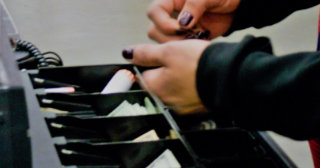Employee theft is rarely as simple as stealing money out of the cash drawer. However, the result is the same. The restaurant loses money. Consequently, slim margins become even more slim. Here are some common ways employees steal from restaurant owners:
- Voiding or “comping” Items after the bill has been paid:
In this scenario, a server charges a customer the correct amount for their order and then voids a portion of the order and keeps the difference. For example, if a family of four each orders a meal, their bill will reflect the four meals. If they pay in cash, the server takes the money to the register and changes the bill to 3 meals by voiding or comping the 4th Then the cost-difference is pocketed. The register tally will reflect the correct number of cash-based sales as it will only account for the 3 meals. In fact, the employee has stolen the cost of a meal. - The Wagon-Wheel:
This method is more common in bars or taverns but could be executed in a restaurant. In this scenario, the server is responsible for making items themselves, such as cocktails or other beverages. When the tab is paid, instead of closing it out, they transfer it to another customer who ordered the same item.
For example, if a customer orders an $8 cocktail and leaves a $10 bill, instead of closing the tab, the server will pocket the $10 and transfer the tab to the next patron that orders the same cocktail. The second customer pays the tab, the server closes the tab and puts the funds in the register. The register only reflects that one cocktail had been ordered, making this difficult to uncover.
- Providing Free Drinks:
Employees will give away free drinks, or other items, to make customers happy or to encourage a larger tip. Many employees may not even recognize this as stealing and consider it part of the customer service experience. However, the restaurant is still paying for the inventory that is being given away for free. Many restaurants depend on drink sales to make up their profit margins, particularly if the drinks contain alcohol.
As a restaurant owner it can be devastating when an employee is stealing, especially if it is not caught for an extended period. Employee Dishonesty coverage compensates restaurant owners for employee theft (of money or property) provided certain criteria is met.
Unreported Crimes: Most employee dishonesty policies will require that you report the crimes committed against your company to law enforcement. Additionally, you’ll need to bring forward charges and cooperate with any official investigations if you want to be reimbursed for theft or fraud damages.
Employees with Criminal Histories: If any of your employees have a history of theft (either from your business or at a previous job) and you’ve been made aware of it, they won’t be covered. If you know that an employee has stolen from you and you forgive them and allow them to keep their jobs, the insurer will not cover you if they steal from you again.
Inventory: If you can prove that an employee has been stealing inventory, the policy will respond to cover your losses. However, if you discover inventory losses later and can’t prove that a crime has occurred, the insurer won’t consider the loss to be crime related.
The information provided does not constitute insurance advice. All content and materials are for general informational purposes only.



